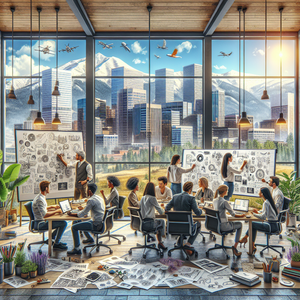The Future of Remote UI/UX Design: Trends to Watch

Virtual reality (VR) is no longer just a buzzword; it’s becoming an integral part of the user experience. As more companies explore immersive environments for education, gaming, and even shopping, UI/UX designers must adapt their skills to create intuitive VR interfaces. Unlike traditional design, VR requires a deep understanding of spatial awareness and user interaction within a three-dimensional space. For example, companies like Oculus and HTC Vive are investing heavily in VR applications that require thoughtful design to ensure users are not only engaged but also comfortable. Designers will need to experiment with new navigation paradigms and interaction models that differ from conventional screens. The shift towards VR opens up possibilities for innovative storytelling, which can enhance user engagement significantly. As VR technology becomes more accessible, designers must prioritize usability within these immersive environments, ensuring that they can cater to a wide range of user experiences.
AI-Driven Design Tools
Artificial intelligence is making waves across various industries, and UI/UX design is no exception. AI-driven design tools are streamlining the design process, enabling designers to create more efficiently by automating repetitive tasks and providing data-driven insights. Tools like Adobe Sensei and Sketch's AI-powered features are examples of how AI can assist designers in making informed decisions based on user behavior and trends. Furthermore, predictive analytics can help designers anticipate user needs and preferences, ultimately leading to more personalized experiences. For instance, AI can analyze user interactions to suggest design improvements or even generate design variations, allowing for rapid prototyping and iterative testing. As AI continues to evolve, designers will need to embrace these tools to stay competitive and enhance their creative processes. The integration of AI not only simplifies workflows but also empowers designers to focus on higher-level creative tasks.
The Increasing Importance of Accessibility
In today’s digital world, inclusivity is paramount. As remote work blurs geographical boundaries, designers are increasingly responsible for creating products that cater to diverse users, including those with disabilities. The demand for accessible design is not just a legal requirement but also a moral obligation, as it ensures that technology is available to everyone. Designers must familiarize themselves with accessibility standards, such as the Web Content Accessibility Guidelines (WCAG), and leverage tools that help evaluate and improve their designs. For example, color contrast checkers and screen reader simulators can provide invaluable insights into how accessible a design truly is. Companies like Microsoft and Google are leading the way in promoting accessibility, setting benchmarks for others to follow. By prioritizing accessibility, designers can contribute to a more equitable digital landscape. As remote work continues to redefine collaboration, the call for inclusive design will only grow stronger.
Remote Collaboration and Communication Tools
As remote work becomes the standard, the need for effective collaboration tools is more critical than ever. Designers must navigate various communication platforms to work with teams across different time zones and cultures. Tools like Figma, Miro, and Slack have become essential in facilitating real-time collaboration, allowing designers to share ideas, provide feedback, and iterate on designs seamlessly. Moreover, the remote work dynamic encourages a more diverse range of voices in the design process. By collaborating with international teams, designers can gain unique perspectives that enrich their work. The challenge lies in fostering a cohesive team culture despite physical distances, which necessitates intentional efforts in communication and relationship-building. Embracing asynchronous communication methods can also enhance productivity, allowing team members to contribute at their convenience.
The future of remote UI/UX design is bright, filled with opportunities for innovation and creativity. As designers embrace the rise of virtual reality, AI-driven tools, and the importance of accessibility, they will not only enhance their skills but also contribute to a more inclusive and engaging digital landscape. By staying informed about these trends and adapting to the changing environment, designers can ensure that they remain relevant and impactful in an ever-evolving industry. The journey ahead may be challenging, but it is also rich with potential for those willing to explore and innovate. As remote UI/UX designer job opportunities expand globally, the ability to adapt and thrive in this dynamic landscape will be a key differentiator for successful designers in the future.
Virtual Reality UI/UX Designer
Oculus, HTC Vive, Sony Interactive Entertainment
Core Responsibilities
Design and develop immersive user interfaces for VR applications, ensuring seamless user interactions within 3D environments.
Collaborate with developers and artists to create engaging experiences that prioritize user comfort and spatial awareness.
Conduct user testing and gather feedback to iterate on designs and improve usability.
Required Skills
Proficiency in VR design tools such as Unity or Unreal Engine.
Strong understanding of human-computer interaction principles specific to virtual environments.
Experience with 3D modeling and animation software.
AI-Enhanced UI/UX Designer
Adobe, Google, IBM
Core Responsibilities
Utilize AI-driven design tools to streamline design processes and enhance user experience through data analytics.
Create user-centered designs based on insights derived from predictive analytics and user behavior data.
Prototype and test design variations rapidly, leveraging AI for iterative design improvements.
Required Skills
Familiarity with AI tools like Adobe Sensei, Sketch, and Figma.
Strong analytical skills to interpret data and make informed design decisions.
Experience in user research and usability testing.
Accessibility-Focused UI/UX Designer
Microsoft, Apple, and nonprofits focused on technology for accessibility
Core Responsibilities
Develop digital products that adhere to accessibility standards, ensuring they are usable by people with disabilities.
Conduct audits and usability tests to identify accessibility issues and implement design modifications.
Create guidelines and resources for teams to ensure inclusive design practices are followed.
Required Skills
In-depth knowledge of WCAG and other accessibility standards.
Proficient in tools like color contrast checkers and screen reader simulators.
Empathy and advocacy for user accessibility needs.
Remote Collaboration Specialist for UI/UX Design
Remote-first companies like GitLab, InVision, and Automattic
Core Responsibilities
Facilitate effective communication and collaboration among remote design teams using various digital tools.
Organize and lead design sprints, brainstorming sessions, and feedback loops across time zones.
Implement best practices for asynchronous communication to enhance team productivity and cohesion.
Required Skills
Expertise in collaboration tools such as Figma, Miro, and Slack.
Strong interpersonal skills and experience in managing remote teams.
Ability to navigate cultural differences and foster an inclusive team environment.
User Researcher for UI/UX Design
Nielsen Norman Group, IDEO, and tech startups focused on user-centered design
Core Responsibilities
Conduct qualitative and quantitative user research to inform design decisions and user experience strategies.
Analyze research findings and present actionable insights to design and development teams.
Facilitate user interviews, usability tests, and surveys to gather feedback and understand user needs.
Required Skills
Strong background in user research methodologies and tools such as UserTesting and Optimal Workshop.
Proficient in data analysis and visualization to communicate findings effectively.
Excellent communication skills for presenting research insights to diverse stakeholders.


